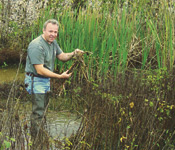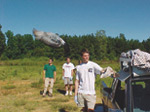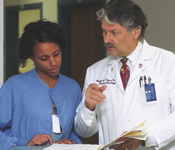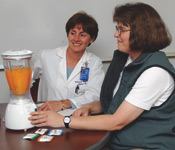
 Dale Nagle collects samples of native plants from a wetland area in northwest Mississippi.
Dale Nagle collects samples of native plants from a wetland area in northwest Mississippi.
These potential cancer fighters are a group of compounds found in a swamp plant commonly known as lizard’s tail (Saururus cernuus), which grows throughout the eastern United States. In lab tests, it suppresses a gene called hypoxia-inducible factor-1, destroying the ability of tumor cells to survive in low-oxygen conditions and, in effect, strangling them.
“These are some of the most potent compounds ever found to inhibit these targets,” says Dale Nagle, associate professor of pharmacognosy in the School of Pharmacy. “It’s exciting because if these compounds work in humans the same way as they do in the lab, we could kill cancer cells without the nasty side-effects of conventional chemotherapy.”
Nagle teamed with molecular biologist Yu-Dong Zhou, postdoctoral research associates Chowdhury Faiz Hossain and Yong-Pil Kim, and pharmacognosy graduate student Tyler Hodges. The team reported its findings in the Journal of Natural Products and is continuing studies of several promising compounds as part of a $1 million, four-year grant from the National Cancer Institute.
The Office of Naval Research initiated the acoustic suppression effort for F/A-18 fighter jets in 2002, providing $2.5 million to the National Center for Physical Acoustics. Led by NCPA associate director John Seiner, the team has made important advances.
“Not only did we completely eliminate the jet’s shock noise, we also experienced good infrared reduction while increasing the engine’s thrust,” Seiner says. The former NASA engineer and his team installed corrugated seals over engine internal divergent flaps on the F/A-18 E/F Super Hornet aircraft. They conducted a full-scale engine test in June at the Naval Air Warfare Center Division in Lakehurst, N.J., reducing the aircraft’s noise by four decibels.
“Past research has successfully suppressed jet noise, but always at the expense of performance,” Seiner says. “This is a first in more than 50 years of research—that the aircraft’s thrust wasn’t compromised.”
In addition to the interview transcripts, which can be found at www.southernfoodways.com, are photographs and biographical essays.
“Most oral histories end up in a filing cabinet,” says John T Edge, director of SFA, part of the Center for the Study of Southern Culture. “But we wanted to embrace the possibilities of the Internet, to disseminate this information on a number of different levels so that it doesn’t die in a filing cabinet.”
People interested in preserving Southern food traditions can participate in the project as interviewers. The SFA Web site offers tips on equipment, labeling, conducting interviews, transcribing and submitting completed oral histories and photographs to SFA.
“We’re really looking to expand right now,” Edge says. “We started with barbecue and hit our stride with the Greenwood project with the help of Viking Range Corp. Then Jim ’N Nick’s (a Birmingham-based barbecue establishment) pledged $75,000 to fund oral histories for the next five years.”

“At first the students were a bit scared to touch the birds,” Buchholz says. “But they got really excited after they released the birds, especially when they saw the birds circling above, sampling various directions.”
Buchholz says the experiment was a success, and he hopes to repeat it next year. All the birds made it home safely, and McGee says that at one point she could see several of her pigeons flying home along I-55.
The students learned that homing, or racing, pigeons—regardless of such factors as age or the direction they start out from—use their internal compasses along with such navigational cues as time of day, position of the sun and landmarks.
UM researchers are working to advance nanotechnology studies by forming an interdisciplinary group to collaborate on projects. The team is composed of about a dozen professors from the chemical, civil, electrical and mechanical engineering departments; a researcher in the physics department; two scientists at the USDA National Sedimentation Laboratory; and professors at Jackson State University, University of Southern Mississippi and University of New Orleans. Each researcher brings a different area of expertise, whether in composite materials, thermal science, poromechanics, wireless communication or fractals.
“Recently, there have been several amazing discoveries in matter at the nano level in medicine, biotechnology and pharmaceuticals,” says Alexander Cheng, chair of civil engineering. “We want to apply those same concepts to engineering to improve the things people use every day.”
Walter Davis, assistant professor of management in the School of Business Administration, is providing key insights with studies conducted in the school’s behavioral research laboratory.
“One important finding is employees are not going to view a peer-review system as credible. They are not going to feel comfortable with the system unless they receive a considerable amount of training on how to use the system,” he says.
Davis, who has published his findings in Group and Organizational Management Journal, also says that, in some cases, giving employees less feedback and less stringent accountability standards can lead to greater interest in the task, greater self-confidence in performing the task and greater performance of the task.
“When people have more flexibility, then creativity and innovation follow, and that’s crucial in today’s work environment,” Davis says.
 Dr. Ralph Vance (right) and staff nurse Kimberle Cheatman
Dr. Ralph Vance (right) and staff nurse Kimberle Cheatman
Participants get routine spiral computed tomography scans at least annually for three to five years. The spiral CT scans the patient’s chest and sends the information to a computer that displays three-dimensional images of the patient’s lungs.
Researchers will continue to track participants through 2009. The study will allow researchers to determine if spiral CTs conducted every six months could be a cost-effective means of diagnosing lung cancer earlier in at-risk populations , says Dr. Ralph B. Vance, professor of medicine and national volunteer president of the American Cancer Society.
“The spiral CT has a very high definition,” Vance says. “It can pick up small lesions without much radiation. We may be able to locate very small tumors—called stage one tumors—and treat these patients with appropriate therapy.”
 Dr. Lenora Bigler (right), clinical professor of dental research, mixes a protein supplement for Dr. Marion Wofford.
Dr. Lenora Bigler (right), clinical professor of dental research, mixes a protein supplement for Dr. Marion Wofford.
Results from the study, conducted with the Tulane University Office of Health Research, should help doctors determine whether dietary soy protein supplements can help prevent and treat hypertension, thus reducing the risk of heart disease. Dr. Marion Wofford, associate professor of medicine and director of the Division of Hypertension at the Medical Center, says the study, called ProBP, also examines the effect of protein on cholesterol and body weight. The National Institutes of Health’s National Heart, Lung and Blood Institute is funding the $2.4 million study.
Wofford, principal investigator of the study, says soy is proven to curb cardiovascular disease. Until now, no large study has been done to evaluate the impact of soy protein on blood pressure.